Essay: Thrive 2018 Conference~ A More Complex Story
by Christina Turczyn
arttimesjournal July 4, 2018
How can we change the conversation from challenges to opportunities…from walls to skies? Beautiful to see a room filled with people as diverse as the country I love, the artists I love…This is an example of what I think we want to do here. This work is about a collective understanding, a collective consciousness…It will only be successful if we do a dance together. --- James Claiborne
Admittedly, I am a change agent. Although individuals who work for change are often suspect at best, it seems to me that change is the most obvious sign of a life lived fully. Whether or not individuals acknowledge it, change happens all the time. Chesley Sullenberger's landing a plane on the Hudson in conditions altered by every second always made me think about how many fields need to intersect for successful navigation during a moment of crisis. What we think of as intuition, perhaps, is something just beyond the horizon of thought—knowledge gathered over the years through experience, summoned through a catalyst, in the way that plein air painters effortlessly render a certain hour of light. Why, then, are people so willing to hold on to a practice of habit—the same route selected on the way to work, the truly imposing lecture, or a language that no longer speaks to the young? The only vitality in language resides in its novelty, as words absorb the cadences of now, so that we live in the present, not in some anachronistic notion of a past that if left unchallenged, becomes a weighty, airless structure in which people die. Deferred Action for Childhood Arrivals is a phrase that has always struck me at my deepest core. At the time of this writing, action is not deferred. Children are living in tent cities. Students are leaving universities. Families are separated, while spaces formerly meant for retail hold toddlers given games. How is it possible to create such a dehumanizing distance between change and acknowledgment, between humanity and possession? Where is the art that will address these questions, an art that will emerge from silenced communities, an art that will not include the phrase “outsider art,” as there is no outside or inside in the dynamics of change, only movement.
Ultimately, entertainment assures us of what we already believe. The arts force us to think slowly. The faster you consume, the faster you replace … The arts force us to slow down, to develop empathy. The arts allow us to consider a more complex story … Everything is designed to be replaced. The arts do something that is diametrically opposed to that. -- Eddie Torres
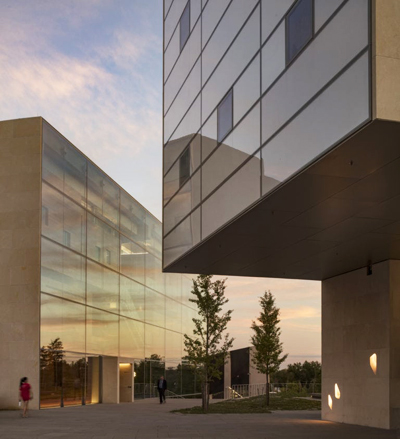 Lewis Center Arts complex (photo) Paul Warchol |
Just a few weeks ago, on June 7, I attended a THRIVE conference at the newly built Lewis Arts complex at Princeton University, organized by the ArtPride New Jersey Foundation, the New Jersey State Council on the Arts, and the Lewis Center for the Arts. According to Koren Rife, Marketing and Communications Manager of ArtPride, the purpose of the meeting for organizational leaders, marketing professionals, and artists was to highlight “the challenges and opportunities facing the state's arts community.” Panels and breakout sessions featured topics of interest for innovative business models, in addition to “shifts in audience demographics and behavior.” Featured speakers included Chris Daggett, President and CEO of the Dodge Foundation, James Claiborne, Public Programming Manager of the African American Museum in Philadelphia, Eddie Torres, President and CEO of Grantmakers in the Arts, Adam Huttler, CEO, of Exponential Creativity Ventures, and Katie Ingersoll, Education Manager of Data Arts. I heard James Claiborne present “Expanding Our Voices to Reflect Changing Demographics,” as well as Chris Daggett and Eddie Torres on “National Trends, Jersey Implications.” What also emerged as vital points of discussion beyond institutional concerns were broad questions critical to communities in the United States—issues of equity, diversity, engagement, change. As an educator, I am constantly trying to create a safe space in which writers take apart preconceptions that hinder vision. James Claiborne reminded audience participants, about the importance of creating a “comfortable place for uncomfortable conversations,” while affirming that the “debate on definition should not deter progress.” Real dialogue emerged at this conference. Leaders of organizations were willing to collaborate, to bring to light difficulties they were facing, and to field challenging questions from participants.
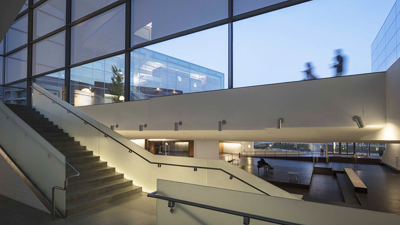 Lewis Center Arts (photo) Paul Warchol |
The Lewis center is angular and spacious, with state-of-the-art
performance, as well as exhibit areas surprising visitors with staircases,
skylights. As in a conversation, space condenses and unfolds, so I
immediately found myself walking around, taking in multiple perspectives,
wondering what was above me, or outside. The building's sculptural planes
opened up, yet not enough to work against its mystery. I wanted to look
behind the next door, and the next….to see where each staircase led.
Representatives from Princeton University's Public Scholars Project invited
attendees to find out more about the university, and I thought about
Poetry, as well as Arts Centers as places of praxis. Many years ago, at the
Poetry Center at Passaic County Community College, I experienced not only
outreach, but being. Not only was the center in a conversation
with the community, but the community, in turn, created lasting change. Not
terribly polite, as transformational words can never be, here was a
language integral to writers' survival. The poets had been there, were
inviting us into the corridors of their memories. Only the most crucial
words were left. If you, as well, had been there, you would hear.
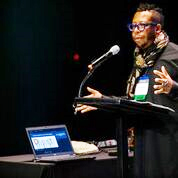 James Claiborne, “Expanding Our Voices to Reflect Changing Demographics” |
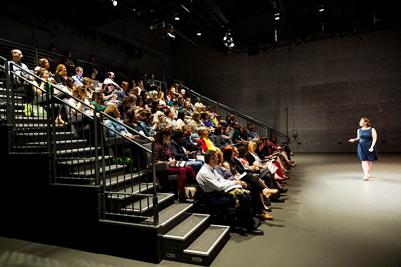 Katryn Geane. “Breaking Through Digital: How to Make Noise with Your
Content” Katryn Geane. “Breaking Through Digital: How to Make Noise with Your
Content” All photos ©ArtPride New Jersey Foundation |
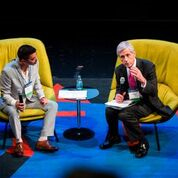 Eddie Torres & Chris Daggett, “National Trends, Jersey Implications” Eddie Torres & Chris Daggett, “National Trends, Jersey Implications” |
THRIVE created a similar space, where critical issues were addressed. For someone like me, a person with a disability, the conference was incredibly accessible, frank. THRIVE is one of the few conferences I have attended in the last several years in which a speaker used the term “differently abled,” asking members of the audience to think about what it means to venture “beyond compliance” so as “to see the person as the person as opposed to a set of parameters.” Beyond organizational issues, timely questions concerning why art matters were raised by all involved. Throughout the day, speakers returned to issues of diversity, technological innovation, community, and dialogue. This conference took risks. Eddie Torres called attention to discussions surrounding citizenship as “the most organized threat to public schools,” since, in his opinion, a need for relevant arts education requires “an accurate population count, especially in immigrant-rich communities,” since otherwise, potentially marginalized communities might be overlooked. I often consider the buried art of migrant communities —the narratives that will remain beyond deportation, as well as the art that questions harrowing conditions. “To whom should I be accountable,” Eddie Torres added. “Who has not been listened to?” Chris Daggett, as well as the keynote speaker, sensitively called attention to economic disparities, as well as to the growing income gap. Chris Daggett also touched upon the devastating impact that the Great Recession had upon families, while Adam Huttler urged that economic disparity needs to be seriously considered in any consideration of the arts. Ann Marie Miller, ArtPride's Director of Advocacy and Public Policy, shared her perspectives concerning ArtPride's cutting-edge initiative, Art Matters. “What is emerging now is the healing power of the arts,” Ann stated. Eddie Torres described arts as an element of health and touched upon its restorative dimension with veterans, as well as many others.
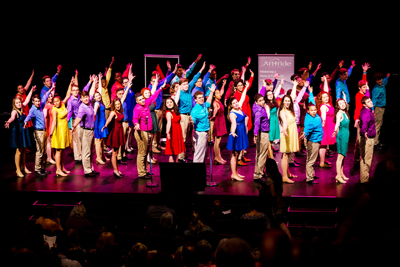 Paper Mill Playhouse Broadway Show Choir © ArtPride New Jersey Foundation |
In my daily life, I am involved in issues of diversity, equity, access, and inclusion. I left the conference feeling empowered and heard. Individuals often speak of moving from the margins to the center, yet perhaps we should reconsider the notion of a center. I remember the profoundly strong, young voices of the Paper Mill Playhouse Broadway Showcase Choir when they sang “Let it Go,” from Frozen. They could be students in any school. I wondered about their stories. Listening to them, I thought that we, as artists and administrators could ask ourselves what kind of dialogue addresses the growing, national abandonment? What kind of art will give us the words to speak about detention? What kind of language can set those narratives free without breaking the narrators in the telling? Without building the distance that keeps all empathy at bay? What kind of art, without engaging the word “other,” reaches out and understands? Are we becoming part of a frozen republic, our recollections buried under snow?
It comes down to, as many of the speakers noted—listening. James Claiborne mentioned that persons who identify with diverse communities usually engage in “conversations in safe spaces that persons in leadership don' t get to hear.” THRIVE brought many of those conversations to the fore.
Not everything that is faced can be changed, but nothing can be changed until it is faced. -- James Baldwin, as quoted by James Claiborne
